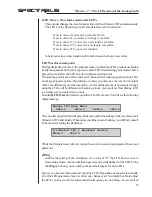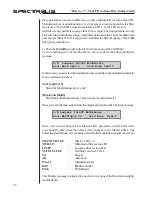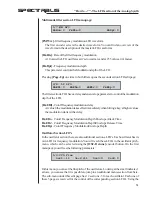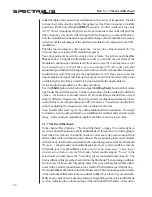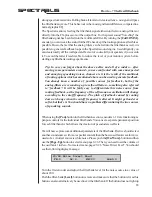
68
SPECTRALIS
your keyboard? Early monophonic synths of the late 60s and early 70s were available
only with two different behaviors: either the highest note played had priority or the
lowest one. This determination definitely was not the result of choice but rather a
result of the technology used. The keyboards at the time used key contacts and a
resister chain. Depending on which way tone recognition was set up the outcome
was either highest note priority or lowest note priority.
Early analog keyboard scanning circuits had another problem too. Overlapping notes
played on the keyboard didn’t retrigger the envelopes – a problem especially for
flashy but somewhat less than precise soloists!
A popular modification for Synthesizers at that time, was to fix this problem with a
multitrigger system. To reset the trigger logic it was now not necessary anymore to
release all keys, instead it was sufficient to change the pitch. These kinds of systems
detected a new note by comparing the keyboard voltage with the last triggered note.
As soon as a difference between the old and the new voltage was detected, this
keyboard logic created a new gate impulse triggering the envelopes. The Mini Moog
for instance didn’t have a retriggering feature for legato notes to begin with – a
severe limitation especially in light of the MM’s outstanding percussive sounds.
With the emergence of digital key control an additional note priority became popular
– the so-called last note priority. Now the pitch of a note wasn’t the decisive factor
in pitch determination but the last note played. With the introduction of digital key
control the retrigger problem became a thing of the past.
Still, not everyone was happy with the new system. It became obvious pretty quickly
that no matter the limitations of the old key-controls, they also offered possibilities
which could be used creatively - especially during solos. When holding the highest
note while playing a solo a lower key rhythmically automatically created a two note
trill which was much easier to play than actually playing both notes rhythmically. Even
the lack of retriggering had its bright sides. It made it possible to control the sound
and to set accents by playing deliberate legato and staccato.
In our opinion it wouldn’t be right to eliminate the possibility to emulate these vintage
note-priority and trigger ”features”. As a result the Spectralis features the following
trigger and note priority settings for all three of its trigger groups:
LAST
Last Note Priority
without
retriggering of envelopes during legato play.
LS-TR
Last Note Priority
with
retriggering of envelopes during legato play.
LOW
Lowest Note Priority
without
retriggering of envelopes during legato play.
LO-TR
Lowest Note Priority
with
retriggering of envelopes during legato play.
HIGH
Highest note priority
without
retriggering of envelopes during legato play.
HI-TR
Highest Note Priority
with
retriggering of envelopes during legato play.
Note priority and multitrigger settings
Summary of Contents for Spectralis
Page 1: ...1 SPECTRALIS Spectralis...




